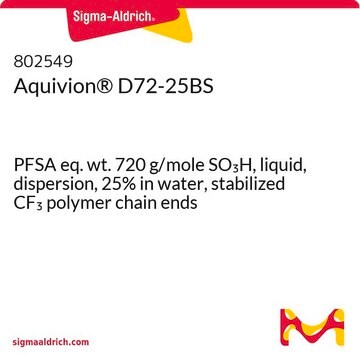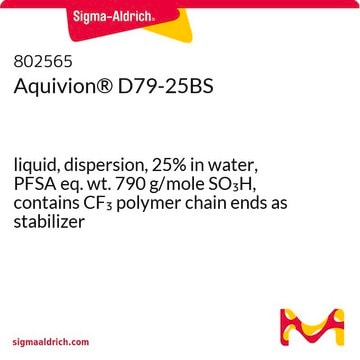565067
Nafion™ perfluorinated membrane
Nafion™ 324, reinforced with poly(tetrafluoroethylene) fiber, thickness 0.006 in.
About This Item
Recommended Products
eq. wt.
1100 2nd membrane
1500 1st membrane
manufacturer/tradename
Nafion™ 324
greener alternative product characteristics
Design for Energy Efficiency
Learn more about the Principles of Green Chemistry.
sustainability
Greener Alternative Product
L × W
12 in. × 12 in.
thickness
0.006 in.
solubility
H2O: insoluble
greener alternative category
, Enabling
InChI
1S/C7HF13O5S.C2F4/c8-1(9)2(10)24-5(15,16)3(11,4(12,13)14)25-6(17,18)7(19,20)26(21,22)23;3-1(4)2(5)6/h(H,21,22,23);
InChI key
FOYUGSIADQEOEK-UHFFFAOYSA-N
Looking for similar products? Visit Product Comparison Guide
General description
Application
Packaging
· Keep pieces sealed and protected from general exposure will reduce the effect. Recommend long term storage in air-tight bags.
· Discoloration does not affect performance and can be removed by soaking in dilute nitric acid.
Legal Information
Storage Class
11 - Combustible Solids
wgk_germany
nwg
flash_point_f
Not applicable
flash_point_c
Not applicable
ppe
Eyeshields, Gloves, type N95 (US)
Certificates of Analysis (COA)
Search for Certificates of Analysis (COA) by entering the products Lot/Batch Number. Lot and Batch Numbers can be found on a product’s label following the words ‘Lot’ or ‘Batch’.
Already Own This Product?
Find documentation for the products that you have recently purchased in the Document Library.
Articles
Polymer electrolyte membrane (PEM) fuel cells offer high efficiency and low-temperature operation, reducing oil use in light-duty vehicle transportation.
Proton exchange membrane (PEM) fuel cells operate at relatively low temperatures and are composed of two electrodes and a conductive elecrolyte.
Advances in electrochemical water conversion and understanding PEMFC degradation drive progress in hydrogen technologies.
Our team of scientists has experience in all areas of research including Life Science, Material Science, Chemical Synthesis, Chromatography, Analytical and many others.
Contact Technical Service







